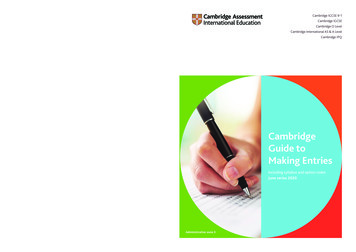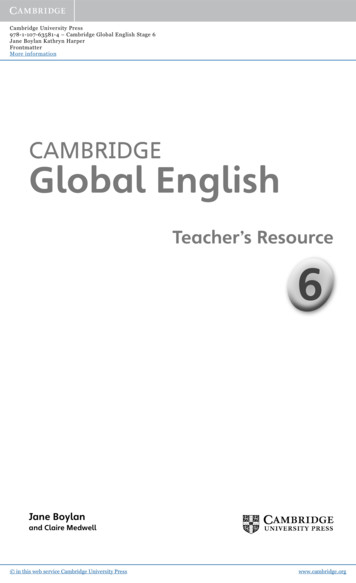Cambridge International AS And A Level Chemistry
Cambridge University Press978-1-107-63845-7 – Cambridge International AS and A Level ChemistryLawrie Ryan and Roger NorrisFrontmatterMore informationLawrie Ryan and Roger NorrisCambridge International AS and A LevelChemistryCoursebookSecond Edition in this web service Cambridge University Presswww.cambridge.org
Cambridge University Press978-1-107-63845-7 – Cambridge International AS and A Level ChemistryLawrie Ryan and Roger NorrisFrontmatterMore informationUniversity Printing House, Cambridge cb2 8bs, United KingdomCambridge University Press is part of the University of Cambridge.It furthers the University’s mission by disseminating knowledge in the pursuit ofeducation, learning and research at the highest international levels of excellence.www.cambridge.orgInformation on this title: www.cambridge.org Cambridge University Press 2011, 2014This publication is in copyright. Subject to statutory exceptionand to the provisions of relevant collective licensing agreements,no reproduction of any part may take place without the writtenpermission of Cambridge University Press.First published 2011Second edition 2014Printed in the United Kingdom by Latimer TrendA catalogue record for this publication is available from the British Library isbn 978-1-107-63845-7 Paperback with CD-ROM for Windows and MacCambridge University Press has no responsibility for the persistence or accuracyof URLs for external or third-party internet websites referred to in this publication,and does not guarantee that any content on such websites is, or will remain,accurate or appropriate. Information regarding prices, travel timetables, and otherfactual information given in this work is correct at the time of first printing butCambridge University Press does not guarantee the accuracy of such informationthereafter.notice to teachers in the ukIt is illegal to reproduce any part of this work in material form (includingphotocopying and electronic storage) except under the following circumstances:(i) where you are abiding by a licence granted to your school or institution by theCopyright Licensing Agency;(ii) where no such licence exists, or where you wish to exceed the terms of a licence,and you have gained the written permission of Cambridge University Press;(iii) where you are allowed to reproduce without permission under the provisionsof Chapter 3 of the Copyright, Designs and Patents Act 1988, which covers, forexample, the reproduction of short passages within certain types of educationalanthology and reproduction for the purposes of setting examination questions.Example answers and all other end-of-chapter questions were written by the authors. in this web service Cambridge University Presswww.cambridge.org
Cambridge University Press978-1-107-63845-7 – Cambridge International AS and A Level ChemistryLawrie Ryan and Roger NorrisFrontmatterMore informationContentsHow to use this bookviChapter 1: Moles and equations1Masses of atoms and moleculesAccurate relative atomic massesAmount of substanceMole calculationsChemical formulae and chemical equationsSolutions and concentrationCalculations involving gas volumesChapter 2: Atomic structureElements and atomsInside the atomNumbers of nucleonsIsotopesHow many protons, neutrons and electrons?Chapter 3: Electrons in atomsSimple electronic structureEvidence for electronic structureSubshells and atomic orbitalsElectronic configurationsOrbitals and the Periodic TablePatterns in ionisation energies in thePeriodic TableChapter 4: Chemical bondingTypes of chemical bondingIonic bondingCovalent bondingShapes of moleculesMore molecular shapesMetallic bondingIntermolecular forcesHydrogen bondingBonding and physical propertiesChapter 5: States of matterStates of matterThe gaseous stateThe liquid stateThe solid stateSimple molecular latticesCarbon nanoparticlesConserving materials in this web service Cambridge University 556586064667273737778808283Chapter 6: Enthalpy changes89What are enthalpy changes?90Standard enthalpy changes92Measuring enthalpy changes94Hess’s law97Enthalpy change of reaction from enthalpychanges of formation97Enthalpy change of formation from enthalpychanges of combustion98Calculating the enthalpy change of hydration of ananhydrous salt99Bond energies and enthalpy changes99Calculating enthalpy changes usingbond energies101Chapter 7: Redox reactions106What is a redox reaction?Redox and electron transferOxidation numbersRedox and oxidation numberNaming compoundsFrom name to formulaBalancing chemical equations using oxidationnumbersChapter 8: EquilibriumChapter 9: Rates of reaction112117119123127129130140Reaction kineticsThe effect of concentration on rate of reactionThe effect of temperature on rate of reactionCatalysisEnzymesStructure of the Periodic TablePeriodicity of physical propertiesPeriodicity of chemical propertiesiii116Reversible reactions and equilibriumChanging the position of equilibriumEquilibrium expressions and the equilibriumconstant, KcEquilibria in gas reactions: the equilibriumconstant, KpEquilibria and the chemical industryAcid-base equilibriaChapter 10: 149154www.cambridge.org
Cambridge University Press978-1-107-63845-7 – Cambridge International AS and A Level ChemistryLawrie Ryan and Roger NorrisFrontmatterMore informationOxides of Period 3 elementsChlorides of Period 3 elementsChapter 11: Group 2Physical properties of Group 2 elementsReactions of Group 2 elementsThermal decomposition of Group 2 carbonatesand nitratesSome uses of Group 2 compoundsChapter 12: Group 17Physical properties of Group 17 elementsReactions of Group 17 elementsReactions of the halide ionsDisproportionationUses of the halogens and their compoundsChapter 13: Nitrogen and sulfurNitrogen gasAmmonia and ammonium compoundsUses of ammonia and ammonium compoundsSulfur and its oxidesSulfuric 1182183185185188Representing organic moleculesFunctional groupsNaming organic compoundsBonding in organic moleculesStructural isomerismStereoisomerismOrganic reactions – mechanismsTypes of organic reaction189192192193194195196198The homologous group of alkanesSources of the alkanesReactions of alkanesThe alkenesAddition reactions of the alkenesOxidation of the alkenesAddition polymerisationTackling questions on addition polymersChapter 16: HalogenoalkanesNucleophilic substitution reactionsMechanism of nucleophilic substitution inhalogenoalkanesElimination reactionsUses of halogenoalkanes in this web service Cambridge University PressThe homologous series of alcoholsReactions of the alcoholsCarboxylic acids226226231Chapter 18: Carbonyl compounds234The homologous series of aldehydes andketonesPreparation of aldehydes and ketonesReduction of aldehydes and ketonesNucleophilic addition with HCNTesting for aldehydes and ketonesReactions to form tri-iodomethaneInfra-red spectroscopyChapter P1: Practical skills 1Review of practical knowledge andunderstandingManipulation, measurement and observationPresentation of data and observationsAnalysis, conclusions and evaluationChapter 19: Lattice energyChapter 14: Introduction to organicchemistryChapter 15: HydrocarbonsChapter 17: Alcohols, esters and 8220222222Defining lattice energyEnthalpy change of atomisation andelectron affinityBorn–Haber cyclesFactors affecting the value of lattice energyIon polarisationEnthalpy changes in solutionChapter 20: ElectrochemistryRedox reactions revisitedElectrolysisQuantitative electrolysisElectrode potentialsMeasuring standard electrode potentialsOvaluesUsing E —Cells and batteriesMore about ter 21: Further aspects of equilibria303The ionic product of water, KwpH calculationsWeak acids – using the acid dissociationconstant, KaIndicators and acid–base titrationsBuffer solutions304305307309313www.cambridge.org
Cambridge University Press978-1-107-63845-7 – Cambridge International AS and A Level ChemistryLawrie Ryan and Roger NorrisFrontmatterMore informationEquilibrium and solubilityPartition coefficients316319Chapter 22: Reaction kinetics324Factors affecting reaction rateRate of reactionRate equationsWhich order of reaction?Calculations involving the rate constant, kDeducing order of reaction from raw dataKinetics and reaction mechanismsCatalysis325325330332334335338340Chapter 23: Entropy and Gibbs free energy 349Introducing entropyChance and spontaneous changeCalculating entropy changesEntropy and temperatureEntropy, enthalpy changes and free energyGibbs free energyGibbs free energy calculationsChapter 24: Transition elementsWhat is a transition element?Physical properties of the transition elementsRedox reactionsLigands and complex formationChapter 25: Benzene and its compoundsThe benzene ringReactions of arenesPhenolReactions of phenolChapter 26: Carboxylic acids and theirderivativesThe acidity of carboxylic acidsOxidation of two carboxylic acidsAcyl chloridesChapter 27: Organic nitrogen compoundsAminesFormation of aminesAmino acidsPeptidesReactions of the amidesElectrophoresis in this web service Cambridge University 387388393394395396Chapter 28: Polymerisation411Condensation polymerisationSynthetic polyamidesBiochemical polymersThe importance of hydrogen bonding in DNAPolyestersDesigning useful polymersDegradable polymersPolymer deductionsChapter 29: Analytical Proton (1H) nuclear magnetic resonanceCarbon-13 NMR spectroscopyMass spectrometry434439444446Chapter 30: Organic synthesis456Designing new medicinal drugs457Chapter P2: Practical skills 2464Written examination of practical skillsPlanningAnalysis, conclusions and evaluation465465468vAppendix 1: The Periodic Table of theElements473Appendix 2: Selected standard electrodepotentials474Appendix 3: Qualitative analysis s and conditions of use for the CD-ROM 494400401402404405406407www.cambridge.org
Cambridge University Press978-1-107-63845-7 – Cambridge International AS and A Level ChemistryLawrie Ryan and Roger NorrisFrontmatterMore informationHow to use this bookEach chapter begins with a shortlist of the facts and concepts thatare explained in it.There is a shortcontext at thebeginning of eachchapter, containingan example of howthe material coveredin the chapter relatesto the ‘real world’.This book does not contain detailed instructions for doing particular experiments,but you will find background information about the practical work you need todo in these boxes. There are also two chapters, P1 and P2, which provide detailedinformation about the practical skills you need to develop during the course.viImportant equations andother facts are shown inhighlight boxes.Questions throughout the text giveyou a chance to check that you haveunderstood the topic you have justread about. You can find the answersto these questions on the CD-ROM.The text and illustrations describe andexplain all of the facts and conceptsthat you need to know. The chapters,and often the content within themas well, are arranged in the samesequence as in your syllabus. in this web service Cambridge University Presswww.cambridge.org
Cambridge University Press978-1-107-63845-7 – Cambridge International AS and A Level ChemistryLawrie Ryan and Roger NorrisFrontmatterMore informationHow to use this bookWherever you need to know how to use a formula to carry out a calculation,there are worked example boses to show you how to do this.Definitions that are required by thesyllabus are shown in highlight boxes.Key words are highlighted in the textwhen they are first introduced.You will also find definitions ofthese words in the Glossary.viiThere is a summary of keypoints at the end of eachchapter. You might findthis helpful when you arerevising.Questions at the end of each chapter are moredemanding exam-style questions, some of whichmay require use of knowledge from previouschapters. Answers to these questions can befound on the CD-ROM. in this web service Cambridge University Presswww.cambridge.org
Chapter 1: Moles and equations 1 Masses of atoms and molecules 2 Accurate relative atomic masses 3 Amount of substance 5 Mole calculations 6 Chemical formulae and chemical equations Enthalpy change of formation from enthalpy 10 Solutions and concentration changes of combustion14 Calculations involving gas volumes 18 Chapter 2: Atomic structure 24
Cambridge International GCE Advanced Subsidiary and Advanced level (AS and A level) 47 Cambridge International General Certificate of Secondary Education (Cambridge IGCSE)/Cambridge International Certificate of Education (Cambridge ICE)/Cambridge GCE Ordinary level (Cambridge O level) 47 Cambridge International Diploma in Business 48 European Baccalaureate (EB) 65 International Baccalaureate .
Cambridge International Advanced Level (A Level) Cambridge International Project (CIPQ) Cambridge International Certificate of Education (ICE Diploma) Cambridge Advanced International Certificate of Education (AICE Diploma) Cambridge Checkpoint and Cambridge Primary Checkpoint qualifications are part of the May 2020 series.
Cambridge Primary Checkpoint Cambridge Secondary 1 (11–14 years*) Cambridge Secondary 1 Cambridge Checkpoint Cambridge Secondary 2 (14–16 years*) Cambridge IGCSE Cambridge Advanced (16–19 years*) Cambridge International AS and A Cambridge Pre-
The Cambridge Companion to Bede. Cambridge Companions to Literature. Cambridge: Cambridge University Press, 2010. Evans, G.R. The Language and Logic of the Middle Ages: The Earlier Middle Ages. Cambridge: Cambridge University Press, 1984. ———. The Language and Logic of the Middle Ages: The Road to Reformation. Cambridge: Cambridge .
Cambridge University Press 978-1-107-63581-4 – Cambridge Global English Stage 6 Jane Boylan Kathryn Harper Frontmatter More information Cambridge Global English Cambridge Global English . Cambridge Global English Cambridge Global English
Cambridge International Examinations is part of the Cambridge Assessment Group. Cambridge Assessment is the brand name of University of Cambridge Local Examinations Syndicate (UCLES), which is itself a department of the University of Cambridge. BLANK PAGE. Title: 5054/41 O Level Physics November 2017 Keywords : CIE,0 Level,Physics,paper 4 Created Date: 1/16/2019 2:18:45 PM .
Sessions: AM morning PM afternoon IG Cambridge IGCSE 9–1 Cambridge IGCSE (9–1) OL Cambridge O Level AS Cambridge International AS Level AL Cambridge International A Level Cambridge inal Exam imetable November 2020 05–09 October 2020 Syllabus/Component Code Duration Session IG Hindi as a Se
Sessions: AM morning PM afternoon IG Cambridge IGCSE 9–1 Cambridge IGCSE (9–1) OL Cambridge O Level AS Cambridge International AS Level AL Cambridge International A Level Cambridge inal Exam imetable June 2019 29 April–03 May 2019 Syllabus/Component Code Duration Session OL Bengali 3204/01 2h A























